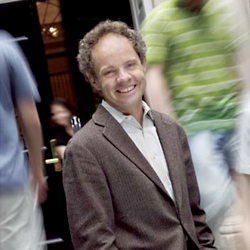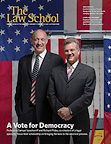We have a tremendous issue here! I am delighted to be able to present you with a timely cover story that will shed light on the intersection between law and politics as we come into the final stretch of the 2008 presidential race. Two of our faculty, Samuel Issacharoff, the Bonnie and Richard Reiss Professor of Constitutional Law, and Richard Pildes, the Sudler Family Professor of Constitutional Law, along with their colleague Pamela Karlan, a professor at Stanford Law School, are the co-creators of a legal field called the Law of Democracy.
 The groundbreaking casebook they published in 1998, The Law of Democracy: Legal Structure of the Political Process, has transformed the way scholars view election law. Defining the cluster of legal issues underpinning the practice and theory of American democracy, their work turned diffuse areas of the law into a coherent discipline—one that is quite popular among law students.
The groundbreaking casebook they published in 1998, The Law of Democracy: Legal Structure of the Political Process, has transformed the way scholars view election law. Defining the cluster of legal issues underpinning the practice and theory of American democracy, their work turned diffuse areas of the law into a coherent discipline—one that is quite popular among law students.
As you may know, each year we highlight an academic area that we are confident a peer review would say is the strongest of its kind among the top law schools. This year that area is the Law of Democracy. Larry Reibstein, the formidable journalist who wrote about Law and Philosophy for the magazine in 2005, explores this new legal specialty in “Leveling the Playing Field.”
As you’ll discover in our story “Follow the Numbers,” Jennifer Arlen ’86, Norma Z. Paige Professor of Law, and Geoffrey Miller, Stuyvesant P. Comfort Professor of Law, are also blazing new trails in the burgeoning area of Empirical Legal Studies, known as ELS. Along with almost two dozen members of the faculty, including Professors Lily Batchelder in tax and social policy, Marcel Kahan in corporate law and Stephen Choi in securities law, Arlen and Miller have been publishing realworld, data-driven research that illuminates a range of public policy matters, and have made NYU Law a locus of ELS activity.
It’s hard to understand why Thomas Buergenthal ’60, who received an honorary doctorate during our most recent commencement ceremonies, isn’t a household name. Read the remarkable story, “From Darkness,” and you will see Buergenthal’s early life was the stuff of nightmares; he was one of the few children to survive the Auschwitz Death March. A judge on the International Court of Justice, and a past judge on and president of the Inter-American Court of Human Rights, Buergenthal has made profound contributions to the cause of human rights. In fact, as the magazine was going to press, he was one of two recipients of the Gruber Foundation International Justice Prize, a $500,000 award honoring those who advance the cause of justice through the legal system.
On a lighter note: Did you know that Professor Roderick Hills Jr. had to find a new home for Reflector, his horse, before coming to NYU? 27 enormously accomplished academics have joined our full-time faculty since 2002. I am also quite proud of all our faculty, and delighted to welcome six new members.
This was a great year for student scholarship. An article that Brian Frye ’05 began as a third year, published in the NYU Journal of Law & Liberty, was cited in Supreme Court Justice Antonin Scalia’s majority opinion in District of Columbia v. Heller. And a paper that Sima Gandhi ’07 (LL.M. ’10) wrote for Batchelder’s tax and social policy seminar won the Brookings Institution’s inaugural Hamilton Project Economic Policy Innovation Prize. To read more about students’ achievements, explore Student Spotlight.
Finally, we are privileged to have so many active and thoughtful alumni. Don’t miss our back page piece about the new president of Taiwan, Ma Ying-jeou (LL.M. ’76), who is married to Chow Mei-ching (LL.M. ’76). The interview was conducted by Law School Professor Jerome Cohen, who taught Ma at Harvard in the 1970s. And many thanks to an alumnus who sent an email last year suggesting that The Law School could improve its environmental practices. This issue is our first printed on paper containing 30 percent post-consumer recycled fiber; as the quality of recycled paper continues to improve, that percentage will increase. So, enjoy, and when you’re finished reading these pages, please be sure to recycle the magazine!
